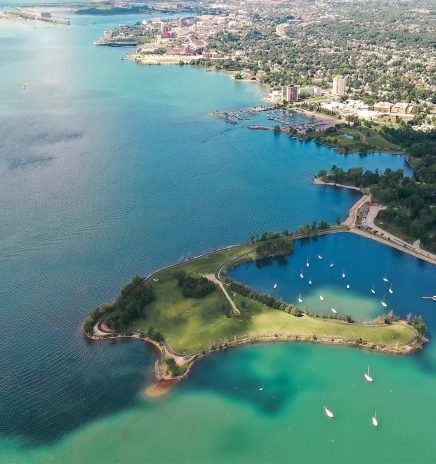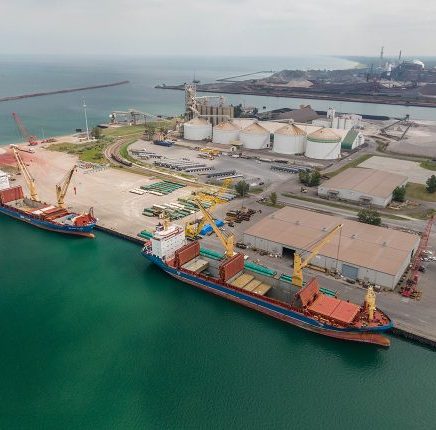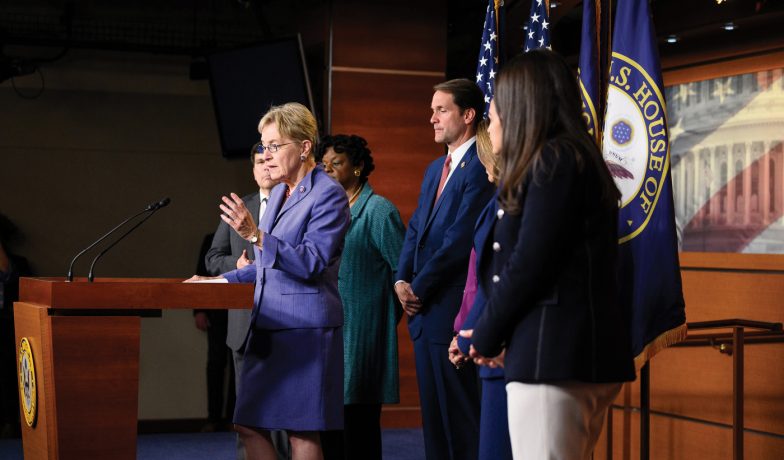Regional Development Strategy: Congresswoman Kaptur Presents Great Lakes as One Region in New Recovery Plan
“There’s a new generation of people who need to see us as a system,” Kaptur says about a move that builds on legislation passed to rename the Saint Lawrence Seaway Development Corporation as the Great Lakes St. Lawrence Seaway Development Corporation (GLS). “We fight so hard for small dollars, and we have the largest body of fresh water in the country. Were also the economic heartland. We need to grow up.”
For Kaptur, growing up involves the region securing federal recognition for what it contributes to the nation. The eight states make up the U. S. portion of the Great Lakes/ Seaway watershed – the core of America’s commercial and defense industrial base. The basins mining, steel production and manufacturing is considered “America’s critical manufacturing sector” by the U.S. Department of Homeland Security (DHS).
The eight states do 25% of all U.S. trade with Canada. Regional trade creates binational economic activity of about $6 trillion annually.
In findings influential in securing federal funds to construct the new Poe-sized lock in Sault Ste. Marie, Michigan, DHS went on to say that “Failure or disruption within these industries would result in cascading disruptions in other critical sectors of the economy, in multiple regions, and have significant national economic impact.”
To protect and maximize the benefits of the region, Kaptur advocates for forming a Great Lakes Authority, as outlined in a 13-page proposal. In addition to representing Ohio’s ninth district, Kaptur co-chairs the Great Lakes Task Force, a bipartisan working group that focuses on enhancing the economic and environmental health of the Great Lakes. The task force’s other co-chairs are Bill Huizenga (R-Michigan), Debbie Dingell (D-Michigan) and David Joyce (R-Ohio).
“This corridor, as Eisenhower imagined, remains critical,” Kaptur says. “The Soo Locks are probably the most strategic point in the region for waterborne commerce and the industrial heartland.”
According to the Great Lakes Authority proposal, Franklin D. Roosevelt created the model for such a strategy in 1933 with the Tennessee Valley Authority (TVA) – “a unique institution brought into being to control the raging waters of the Tennessee River, provide low-cost electricity and advance the economic development of the under-invested seven states in the basin.”
Since then, major federal regional commissions, authorities and bureaus have been created to encompass most United States watersheds – excluding the Great Lakes states. Regional authorities and similar groups unite municipalities from various levels. Together, they better show the impacts of funding initiatives such as the Great Lakes Restoration Initiative and annual budget appropriations for coastal resiliency and infrastructure maintenance and modernization.
Without the authority, Kaptur considers the Great Lakes states at a disadvantage for funding opportunities.
“Our times require a 21st Century version of such an authority in the Great Lakes region – one that can protect and wisely use the freshwaters of the Great Lakes, build back the regions economy and be a necessary example for climate change remediation,” Kaptur says.
The Great Lakes Authority would:
- Restore and protect America’s principal source of freshwater,
- Foster innovation, commercialize it and create more and better jobs,
- Strengthen and expand the core U.S. manufacturing defense industrial base and the energy systems needed to sustain production,
- Create world-class worker education, training and adjustment institutions and
- Partner with federal and provincial leaders of Canada on the region’s mutual challenges, including the GLS in the process.
“The Great Lakes Authority would be modeled after the TVA, the Appalachian Regional Commission, the Bureau of Reclamation out west and the Bureau of Land Management,” Kaptur says. “I’ve been talking about this with the Great Lakes mayors and governors and other members of Congress. They are supporting this effort.
“The freight is growing so much. We’ve got to be a major player.”
GLA Structure
The next step is to officially establish the authority to serve as a federal umbrella to aid in further educating Congress about the Great Lakes states’ role in the nation’s economy and security.
If finalized, the authority chair would be a Cabinet-level appointment by the President and be confirmed by the Senate. Four more appointees would round out the bipartisan board. The authority would be funded through similar means as the Tennessee Valley Authority and the Bureau of Reclamation, which includes both federally appropriated funds and revenues generated by authority projects.
The authorization would make way for a regional infrastructure bank that could finance domestic civil works projects. It could create and operate a business development fund to assist and expand regional manufacturers, fund university-based research, the 18th national laboratory, patent hub and more.
Established Need
To keep raw materials moving, steelmaking happening and manufacturing taking place, funding is needed to maintain and renew the region’s locks, icebreakers, infrastructure and ecosystem. While recent federal funding for Great Lakes programs is meeting current needs, there have been years when ships were forced to light-load for lack of dredging dollars and vessels have been stranded in ice awaiting icebreaking resources.
The GLA, a concept Great Lakes elected officials have been considering since before the 2008 recession, is expected to be a tool to rebuild the region. The U. S. has closed 91,000 factories and lost five million manufacturing jobs since NAFTA was enacted in 1993 and China joined the World Trade Organization in 2000, according to the Bureau of Labor Statistics. The region’s eight states lost 1.5 million of those jobs – 30% of the national loss.
The loss of these jobs has weakened the regional economy, down to the state and local governments. The GLA plan uses municipal indebtedness of Great Lakes cities as an indicator. Detroit and Cleveland, for example, have accrued bond debt of more than $2 billion. Toledo owes $1.6 billion and Milwaukee almost $1.4 billion.
“Faced with the high costs of operation, repairs, rehabilitation and replacement, coupled with unavoidable federal mandates that come with only 50% funding, these cities are forced to increase utility rates on customers who are already in economic trouble,” the plan states.
Kaptur says that a primary example of the effectiveness of an authority comes with TVA, a region which was able to guarantee a 30-year power rate to encourage development. In the Great Lakes, individual municipalities are left to win the confidence and contracts of companies looking to expand into new space. The overarching situation has negatively impacted regional innovation, a characteristic measured by product patents.
Known Advice
When the economy crashed and the U. S. automobile industry suffered great losses a decade ago, regional leaders commissioned The Brookings Study. Results from the study showed that consensus and increased public-private partnerships (P3) were the route to create the next economy. The consensus was a call for federal, state and metropolitan leaders to join with private and philanthropic sectors to:
- Invest in assets that matter, like innovation, infrastructure and human capital,
- Devise new P3 institutions that are market-oriented and performance driven and
- Reimagine governance structures to set the right conditions for economic growth.
According to the GLA plan, that advice was never realized amid political changes and gridlock.
“Neither the state, nor local governments, nor the industries, nor the companies, nor the people of the region could meet the magnitude of this challenge alone,” the plan states. “Nor could they form a joint regional strategy because there was no regional institution through which the leaders of the region could define, advocate and create such a truly regional strategy.
“What the Great Lakes region needed then, and needs even more now, is a 21st Century GLA – an institution that can help the region innovate, create jobs and confront the compounding environmental and climate challenges.”
In Kaptur’s words: “I’m trying to develop a mechanism so the Great Lakes region can catch up.”
Her vision includes more containers moving products through rivers and Lakes, stable power prices created through a binational partnership that taps into more renewable sources and further development in the Straits of Canso, where international vessels load and unload record amounts of cargo for delivery through the regions intermodal system.
The authority is expected to educate members of Congress. It could provide improved access to federal funding while also showcasing the region as an ideal place to innovate and establish new business.
“We’ve had a problem in dry states gaining traction on the role the Great Lakes play,” Kaptur adds. “I’ve always wanted to have a big fish fry here and invite everyone. Whenever the members sit and look at any of the Great Lakes, they say, ‘I can’t see to the other side.’ It’s like they’re discovering a new world.”

HOPA Ports Seeks to Build New Port at Sault Ste. Marie
In September, the Hamilton Oshawa Port Authority (HOPA) and the city of Sault Ste. Marie, Ontario, announced a partnership to develop a multimodal port and trade corridor connecting northern Ontario... Read More

Ports of Indiana Receives FEMA Grants for Security
Ports of Indiana has been awarded two federal grants from the Federal Emergency Management Agency (FEMA) to strengthen security infrastructure and assessment capabilities at its Burns Harbor and Jeffersonville ports. The FEMA Port... Read More



